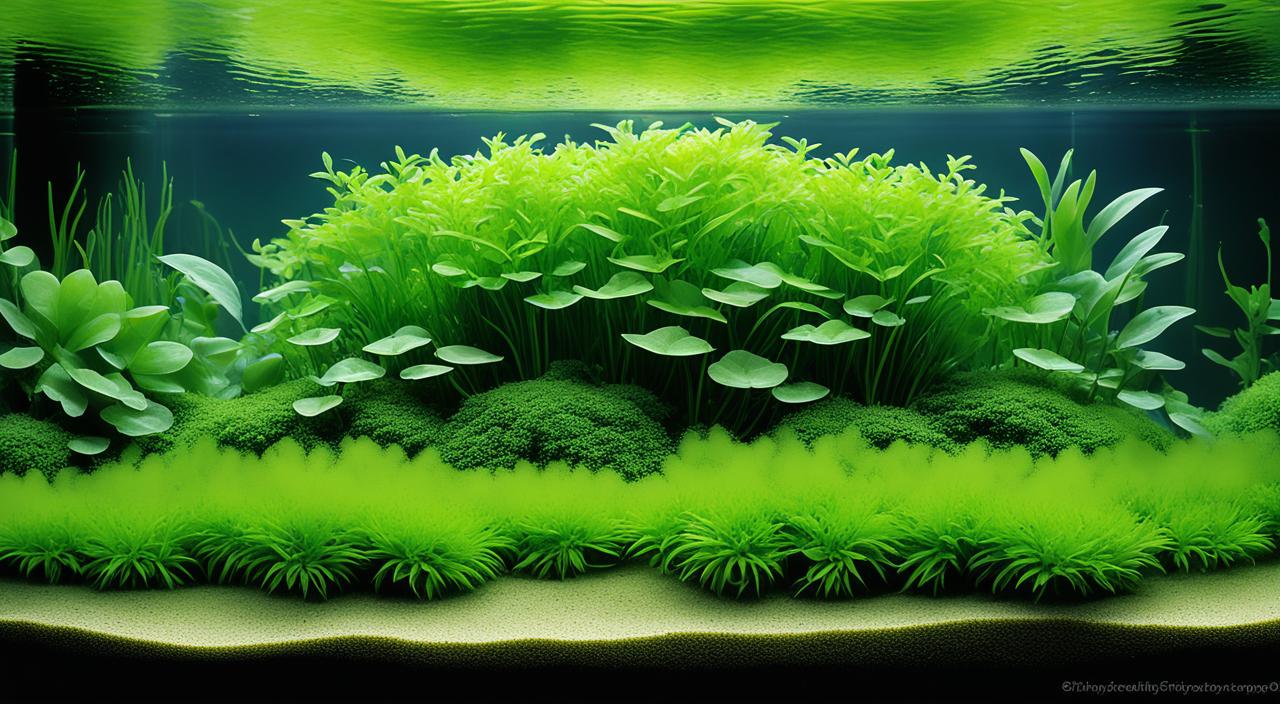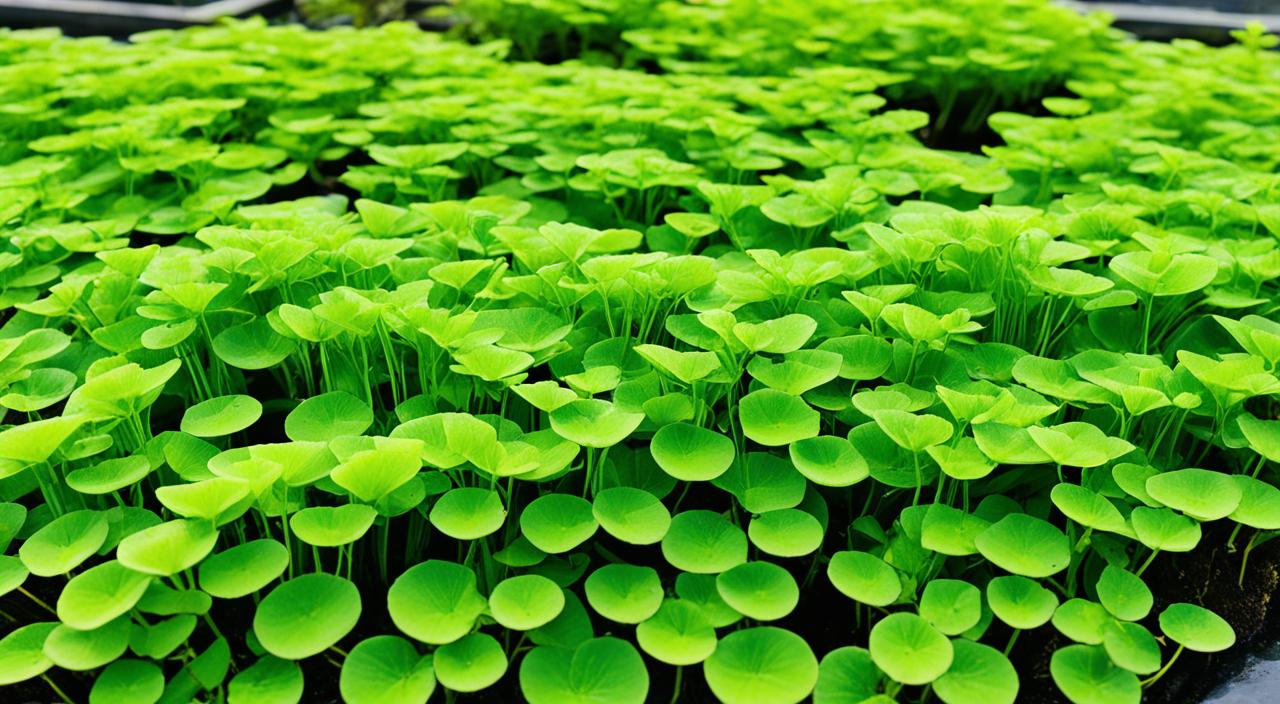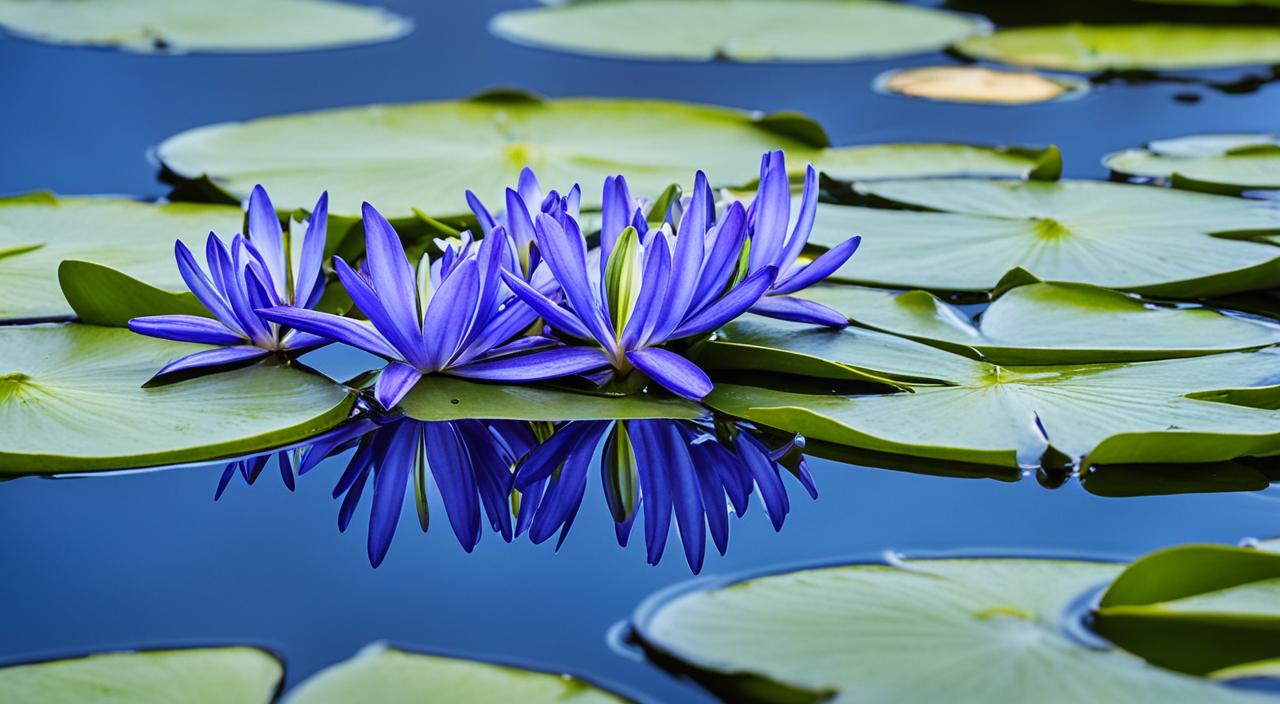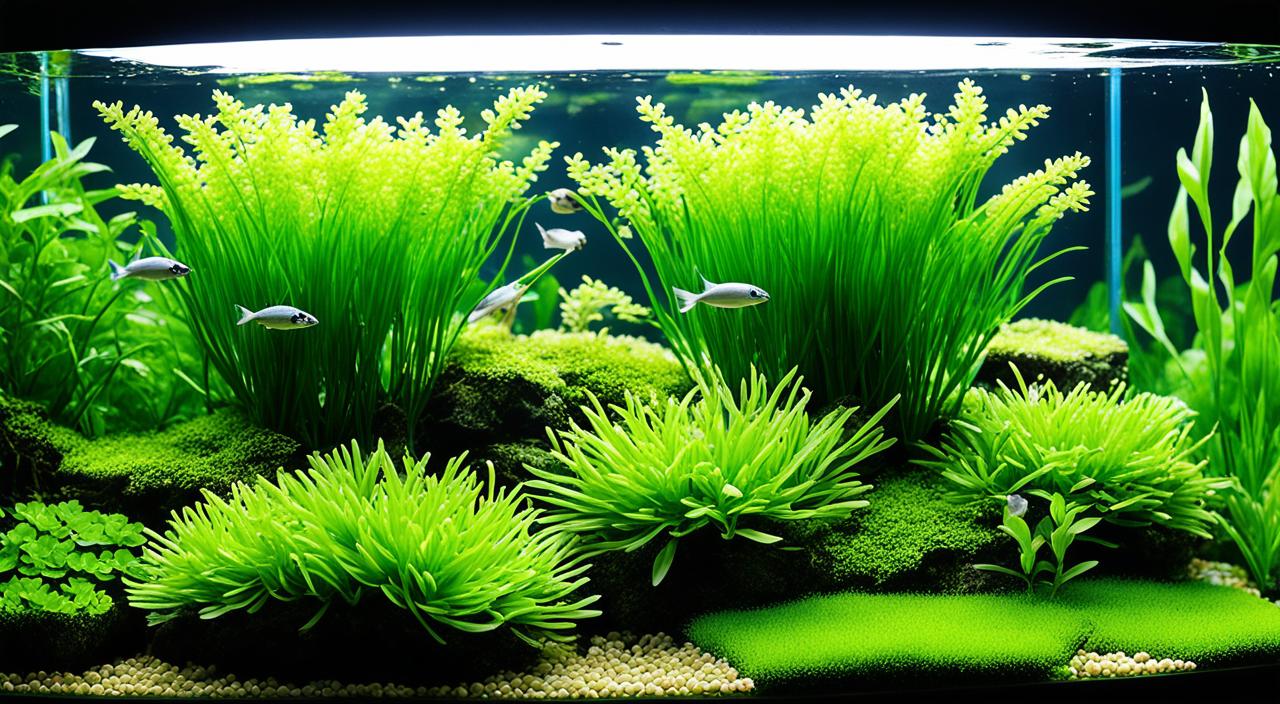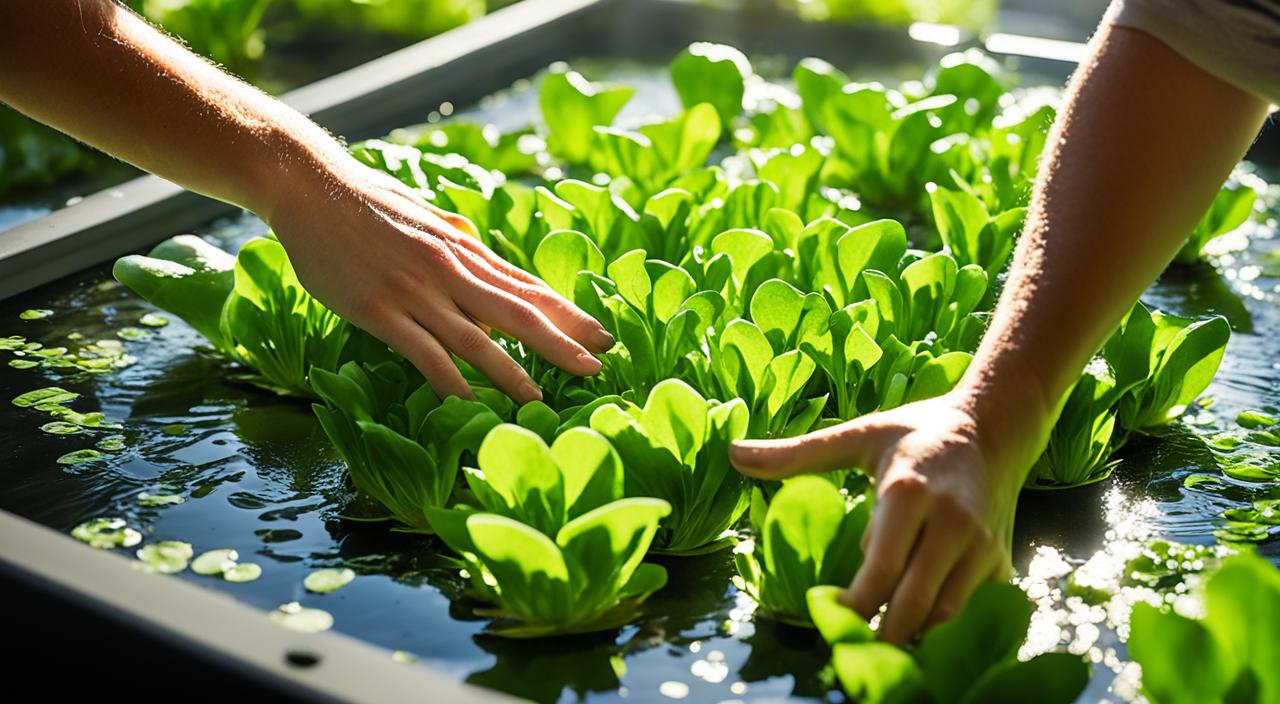Regarding floating aquarium plants, one species stands out for its ability to efficiently remove nitrates from the water and provide a lush and beautiful environment for aquatic inhabitants – Giant Duckweed, or Spirodela polyrhiza. As a native plant in Florida, the Giant Duckweed is the largest and commonly found in rivers, ponds, lakes, and wetlands.
Giant Duckweed features rounded leaves that are usually connected, forming a dense mat on the water’s surface. Its underleaf surface is dark red, which differentiates it from other species. This versatile plant is often used in aquariums and ponds for its water-cleansing benefits and its ability to provide shade and surface cover for aquatic organisms.
If you’re looking for a floating plant that enhances the aesthetics of your aquatic setup and helps maintain water quality, Giant Duckweed is an excellent choice. In this article, I will provide a comprehensive guide on caring for Spirodela polyrhiza and maximizing its efficiency in nitrate removal.
Key Takeaways:
- Giant Duckweed, or Spirodela polyrhiza, is a floating aquarium plant that efficiently removes nitrates from the water.
- This plant provides shade and surface cover for aquatic inhabitants, making it ideal for maintaining a healthy aquatic ecosystem.
- Giant Duckweed has rounded leaves, usually connected, and its underleaf surface is dark red, distinguishing it from other species.
- It is a versatile plant that can thrive in various water conditions and is commonly used in aquariums and outdoor ponds.
- Proper placement, lighting, and water quality are crucial for the successful growth of Giant Duckweed.
Brief Overview Of Giant Duckweed (Spirodela polyrhiza)
Giant Duckweed, or Spirodela polyrhiza, is a versatile plant commonly found in freshwater habitats such as ponds, lakes, and wetlands. It is known for quickly covering the water’s surface, providing shade and reducing light availability for algae growth.
| It is not necessary, but can benefit from it | Description |
|---|---|
| Scientific Name | Spirodela polyrhiza |
| Common Names | Giant Duckweed, Greater Duckweed |
| Origin | Worldwide |
| Height | 0.5 – 1 cm (floating on the surface) |
| Growth Rate | Fast |
| Colour | Green |
| Aquarium Placement | Water surface |
| Water Type | Freshwater |
| pH | 5.0 – 7.5 |
| Care Level | Easy |
| Light Requirements | Moderate to high; 50 – 70 µmol/m²/s PAR, 5000 – 7000 Kelvin, 10 – 12 hours of light per day |
| CO2 Requirements | Not necessary, but can benefit from it |
| Temperature | 15°C – 30°C (59°F – 86°F) |
| Flow Rate | Low to moderate; prefers still water but can tolerate gentle flow |
| Propagation | Vegetative, through daughter plants |
| Feed Type | Absorbs nutrients from the water; additional fertilization not necessary but can promote growth |
The light requirements for Giant Duckweed are pretty adaptable, but a moderate to high light intensity benefits optimal growth. The PAR (Photosynthetically Active Radiation) should be in the range of 50 – 70 µmol/m²/s. The colour temperature of the light should ideally be between 5000 – 7000 Kelvin to mimic natural daylight conditions, which most aquatic plants generally prefer. Giant Duckweed should receive around 10 – 12 hours of light daily to thrive. However, it’s important to note that while Giant Duckweed can grow under a wide range of lighting conditions, too much light can promote excessive growth, which might require regular management to prevent the plant from covering the entire water surface and blocking light from submerged plants.
Giant Duckweed is a high-growth plant that can reproduce rapidly under favourable conditions, making it an efficient choice for those looking to establish a lush aquatic ecosystem. It is a popular choice for aquariums and outdoor ponds due to its hardiness and ability to thrive in various water conditions.
Origins And Habitat
Giant Duckweed, or Spirodela polyrhiza, is a versatile aquatic plant native to Florida and can be found in freshwater habitats worldwide. It is particularly notable for its adaptability and ability to thrive in a variety of water conditions. Due to its unique properties, Giant Duckweed is frequently used in aquaponics systems as a natural filter for water purification.
In its natural habitat, Giant Duckweed forms dense floating mats on the surface of ponds, lakes, and wetlands. These mats provide essential habitat and food sources for various aquatic organisms, contributing to the overall balance and health of the ecosystem. The ability of Giant Duckweed to remove excess nutrients from the water makes it an ideal choice for maintaining water clarity and quality.
| Key Features | Benefits |
|---|---|
| Native to Florida | Adapts well to various water conditions |
| Forms dense floating mats | Provides habitat and food sources for aquatic organisms |
| Used in aquaponics systems | Natural water purification and nutrient removal |
Morphological Characteristics
Giant Duckweed, or Spirodela polyrhiza, is easily recognizable by its small rounded leaves that form interconnected mats on the water surface. These leaves are typically dark green, with a distinct dark red underside that sets them apart from other duckweed species. The plant’s roots hang beneath each leaf, providing stability and anchorage in the water.
This versatile plant has two main methods of propagation. Fragmentation occurs when small pieces of the plant break off and can grow into new individuals. This method allows for rapid and widespread distribution of Giant Duckweed across bodies of water. Additionally, Giant Duckweed can reproduce sexually, developing male and female flowers that produce seeds.
The rapid growth rate of Giant Duckweed allows it to cover large areas quickly. This characteristic makes it an ideal choice for those looking to establish surface cover in their aquatic environments or those seeking efficient plant propagation.
Placement And Lighting
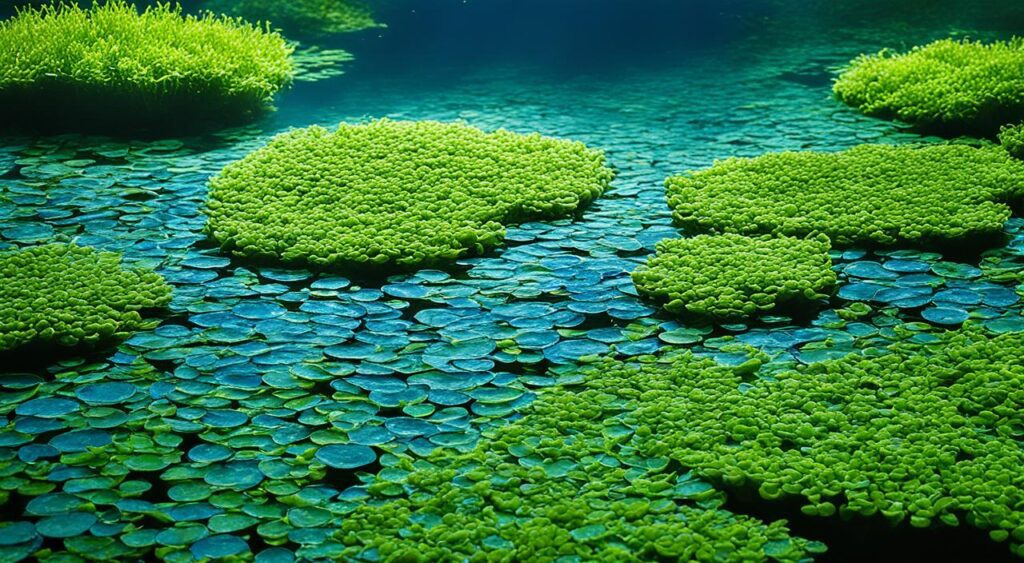
Giant Duckweed, or Spirodela polyrhiza, is a floating plant that requires ample sunlight to thrive. It should be placed in an area of the aquarium or pond where it can receive direct or indirect sunlight to support its photosynthesis process. Without sufficient light, Giant Duckweed may become pale and fail to grow. However, it is important to ensure that the plant does not receive excessive light, as this can lead to the growth of algae and other unwanted organisms. Proper placement and lighting are crucial for the healthy growth of Giant Duckweed in an aquatic environment.
When positioning Giant Duckweed in an aquarium, consider placing it near the water’s surface where it can receive maximum sunlight exposure. This will provide the necessary light for photosynthesis and promote healthy growth. In outdoor ponds or water gardens, ensure that the area where Giant Duckweed is placed receives adequate sunlight throughout the day.
What Are Good Tank Mates?
Giant Duckweed, or Spirodela polyrhiza, is a versatile and adaptable floating plant that can coexist with various aquatic species in an aquarium or pond. It provides shade and surface cover, creating a natural habitat for small fish, invertebrates, and beneficial microorganisms. When selecting tank mates for Giant Duckweed, it is essential to choose species that will not eat or uproot the plants, as they can damage or destroy the delicate foliage.
Good Tank Mates
Some good tank mates for Giant Duckweed include:
- Small freshwater fish like guppies, mollies, and tetras
- Non-aggressive invertebrates like snails and shrimp
These organisms can benefit from the shade and shelter provided by the Giant Duckweed, creating a harmonious and balanced aquatic environment.
Fish Species To Avoid
It is essential to avoid fish species known to eat or uproot the plants, as they can damage or destroy the Giant Duckweed. Some fish species to avoid include:
- Goldfish
- Cichlids
By choosing compatible tank mates and avoiding species that may harm the plants, you can maintain the health and beauty of your aquatic ecosystem while enjoying the benefits of floating aquarium plants like Giant Duckweed.
Feeding (Fertilization)
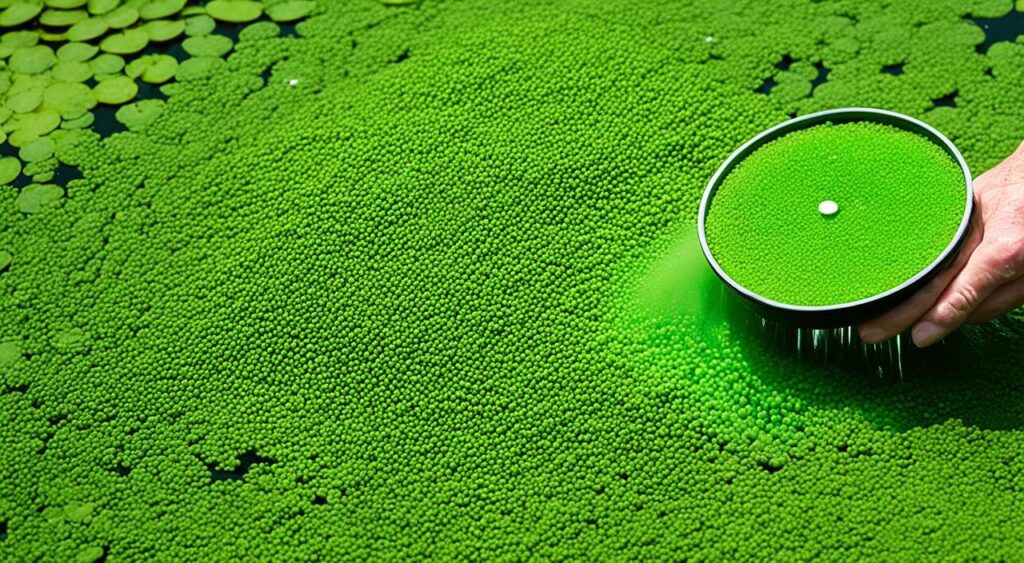
Giant Duckweed, or Spirodela polyrhiza, obtains nutrients primarily from the water it grows in. It is a highly efficient plant at absorbing nutrients, including nitrates, from the water column. In most cases, additional fertilization is not necessary as long as the water contains an adequate amount of nutrients. It is important to monitor the nitrate levels in the water and maintain a suitable balance to support the healthy growth of Giant Duckweed. Overfeeding or excessive fertilization can lead to the overgrowth of algae and other unwanted complications.
Proper fertilization is crucial for the overall health and growth of aquatic plants. However, Giant Duckweed can absorb nutrients directly from the water, making additional fertilization usually unnecessary. Instead, it is essential to maintain the water quality and nutrient levels to ensure healthy plant growth. Monitoring and managing nitrate levels is vital, as excessive nitrates can lead to algae problems and imbalanced ecosystem. Maintaining a well-balanced environment allows Giant Duckweed to thrive and provide valuable benefits in an aquatic setting.
CO2 Injection
Giant Duckweed, or Spirodela polyrhiza, does not require additional CO2 injection to thrive. It obtains carbon dioxide from the air and utilizes it during photosynthesis. The plant can efficiently utilize available carbon dioxide in the water without the need for supplemental CO2 injection. However, if the aquarium or pond is heavily planted with other species that require CO2 supplementation, providing a balanced CO2 level for the overall aquatic ecosystem may be beneficial.
Care
Giant Duckweed, or Spirodela polyrhiza, is a relatively low-maintenance plant that can thrive in various water conditions. However, there are some care considerations to ensure its optimal growth.
Planted Tank Parameters
The parameters in a planted tank should be suitable for both the Giant Duckweed and other aquatic plants. This includes maintaining appropriate water quality parameters such as temperature, pH, and hardness.
Water Quality
Proper water quality is vital for the health and growth of Giant Duckweed. Regular testing and monitoring of water parameters is essential to ensure they remain within the optimal range. This includes maintaining the right temperature, pH level, and water hardness.
| Parameter | Ideal Range |
|---|---|
| Temperature | 20-28°C (68-82°F) |
| pH Level | 6.5-7.5 |
| Water Hardness | 2-10 dKH |
Filtration
Proper filtration is essential to remove excess organic matter and maintain water clarity. A sound filtration system will help to minimize the accumulation of waste material, which can adversely affect the health of Giant Duckweed and other aquatic organisms.
Flow
Adequate water flow should be provided to prevent stagnant conditions and promote the circulation of nutrients throughout the aquarium or pond. Water flow helps distribute oxygen and nutrients to the Giant Duckweed, contributing to its overall health and growth.
Aquarium Maintenance
Proper aquarium maintenance is essential for the health and vitality of Giant Duckweed, or Spirodela polyrhiza, and other aquatic organisms in your tank. Regular testing of water conditions is crucial to identify potential issues and take necessary actions to maintain a balanced environment. Testing parameters such as ammonia, nitrite, and nitrate levels will help you ensure optimal water quality for the well-being of your plants and fish.
When setting up your aquarium tank for Giant Duckweed, it’s essential to consider several factors. Providing suitable lighting is crucial to support the photosynthesis process of the plants. Proper filtration is necessary to remove waste and maintain water clarity. Additionally, maintaining appropriate water parameters such as temperature, pH, and hardness is vital for your aquatic ecosystem’s overall health and growth.
To propagate Giant Duckweed, you can utilize two methods. Division involves splitting the plant into smaller sections, each of which can grow into a new individual. Alternatively, you can collect seeds produced by the plant and use them to cultivate new plants. By utilizing these propagation methods, you can create a thriving population of Giant Duckweed in your aquarium.
Testing Water Conditions
Regularly testing the water conditions in your aquarium is crucial to ensure the health of Giant Duckweed and other aquatic organisms. By monitoring parameters such as ammonia, nitrite, and nitrate levels, you can identify any imbalances and take appropriate actions. Testing kits are widely available and easy to use, allowing you to maintain optimal water quality for your plants and fish.
How To Set Up Your Aquarium Tank
Remember several vital considerations when setting up your aquarium tank for Giant Duckweed. Ensure your tank has suitable lighting to support the plants’ photosynthesis process. Select a filtration system that is appropriate for your tank’s size and your aquatic ecosystem’s needs. Lastly, maintain proper water parameters such as temperature, pH, and hardness to create an ideal environment for the growth and well-being of your Giant Duckweed.
Propagation Methods
Two main methods to propagate Giant Duckweed are division and seed collection. Division involves separating the plant into smaller sections, each capable of growing into a new individual. Collecting seeds produced by the plant provides another method to propagate Giant Duckweed. By utilizing these propagation methods, you can expand the population of Giant Duckweed in your aquarium and ensure its long-term health and growth.
Health And Disease
Ensuring the health of your Giant Duckweed, or Spirodela polyrhiza, is crucial for its overall well-being and longevity in your aquarium or pond. Understanding the signs of good health, identifying potential issues, and taking appropriate measures can help your plant thrive and flourish in its aquatic environment.
Signs Of Good Health
A healthy Giant Duckweed plant exhibits several key indicators:
- Lush green colour: A vibrant green colour indicates active photosynthesis and optimal nutrient uptake.
- Active growth: The plant’s leaves should continue to grow and expand, covering the water surface efficiently.
- Absence of wilting or yellowing leaves: Healthy plants have firm, turgid leaves without any signs of wilting or yellowing, which can indicate nutrient deficiencies or other issues.
Signs Of Poor Health
If your Giant Duckweed shows any of the following signs, it may be experiencing poor health:
- Pale or discoloured leaves: Yellowing, browning, or overall paleness can suggest nutrient deficiencies or other stress factors.
- Stunted growth: If the plant’s growth is sluggish or limited, it may not receive adequate nutrients or appropriate environmental conditions.
- Signs of decay: Rotting or decaying leaves may indicate bacterial or fungal infections, nutrient imbalances, or poor water quality.
Common Health Issues And Treatment
Giant Duckweed can face a few common health issues that can be addressed with appropriate care:
- Nutrient deficiencies: Proper water quality and the addition of suitable fertilizers can help address nutrient deficiencies in the plant.
- Water quality problems: Monitoring and maintaining proper water parameters, such as pH, temperature, and nitrate levels, can prevent stress and promote plant health.
- Plant pests: Giant Duckweed may be susceptible to pests such as snails, which can be manually removed or controlled using appropriate pest control methods.
Plant Pests
Giant Duckweed, like any other aquatic plant, may encounter pests that can disrupt its health:
- Snails: Snails can feed on Giant Duckweed, causing damage or inhibiting its growth. Manual removal and introducing snail-eating fish or snail control measures can help mitigate this issue.
| Plant Pests | Treatment |
|---|---|
| Snails | Manual removal or introducing snail-eating fish, such as loaches or pufferfish, can help control snail populations. |
By maintaining a close eye on the health of your Giant Duckweed and promptly addressing any issues or pests, you can ensure its continued vitality and enhance the overall beauty of your aquatic setup.
Summary
Giant Duckweed, or Spirodela polyrhiza, is a valuable addition to aquariums and ponds because it provides shade, surface cover, and efficient nitrate removal. This versatile plant contributes to the overall health and beauty of the aquatic ecosystem. By following proper care guidelines and addressing potential health issues, enthusiasts can enjoy the many benefits of Giant Duckweed.
Proper care is essential for the success of Giant Duckweed. It thrives in suitable locations with ample lighting and appropriate water quality. Regular monitoring and maintenance, including testing water conditions and maintaining filtration systems, help ensure the plant’s health and vitality.
One of the notable characteristics of Giant Duckweed is its rapid growth and ease of propagation. Through division or the collection of seeds, new plants can be established and added to aquatic environments. The propagation process allows for the expansion and maintenance of Giant Duckweed populations.
Overall, Spirodela polyrhiza is an excellent choice for establishing and maintaining a healthy aquatic ecosystem. Its ability to provide shade, surface cover, and efficient nitrate removal makes it a valuable water purification plant. By paying attention to proper care, propagation methods, and any potential health issues, enthusiasts can enjoy the benefits that Giant Duckweed brings to their aquariums and ponds.
FAQ
What is Giant Duckweed (Spirodela polyrhiza)?
Giant Duckweed is a versatile floating aquatic plant that is commonly used in aquariums and ponds. It is known for its ability to efficiently remove nitrates from the water and provide shade and surface cover for aquatic inhabitants.
Where is Giant Duckweed commonly found?
Giant Duckweed is frequently found in rivers, ponds, lakes, and wetlands. It is native to Florida but can be found in freshwater habitats worldwide.
What are the characteristics of Giant Duckweed?
Giant Duckweed has rounded leaves that are usually connected, and dark red underleaf surfaces. It is a fast grower and can cover large areas in a short period of time. It can reproduce through fragmentation or by producing male and female flowers that develop into seeds.
What are the light requirements for Giant Duckweed?
Giant Duckweed requires ample sunlight to thrive. It should be placed in an area where it can receive direct or indirect sunlight to support its photosynthesis process, but excessive light should be avoided to prevent the growth of algae.
What are good tank mates for Giant Duckweed?
Good tank mates for Giant Duckweed include small freshwater fish like guppies, mollies, and tetras, as well as non-aggressive invertebrates like snails and shrimp.
Does Giant Duckweed require additional fertilization?
Giant Duckweed obtains nutrients primarily from the water it grows in and is a highly efficient plant at absorbing nutrients, including nitrates. Additional fertilization is usually not necessary as long as the water contains adequate nutrients.
Does Giant Duckweed require CO2 injection?
Giant Duckweed obtains carbon dioxide from the air and does not require additional CO2 injection to thrive. It can efficiently utilize available carbon dioxide in the water without supplemental supplementation.
What is the care required for Giant Duckweed?
Giant Duckweed is relatively low-maintenance but requires suitable placement, lighting, water quality, and filtration. Regular aquarium maintenance, including testing water conditions, is important for its health and vitality.
How do I propagate Giant Duckweed?
Giant Duckweed can be propagated through division or by collecting seeds produced by the plant. Division involves separating a portion of the plant and allowing it to grow into a new individual.
What are the signs of good health for Giant Duckweed?
Signs of good health for Giant Duckweed include lush green color, active growth, and the absence of wilting or yellowing leaves.
What are the common health issues for Giant Duckweed?
Giant Duckweed can experience nutrient deficiencies and may be susceptible to pests such as snails. Proper water quality and fertilization can address nutrient deficiencies, while manual removal or appropriate pest control measures can control pests.
What are the benefits of Giant Duckweed?
Giant Duckweed provides shade, surface cover, and efficient nitrate removal capabilities, making it an ideal choice for maintaining a healthy and balanced aquatic ecosystem in aquariums and ponds.
How can I maintain a healthy aquatic environment with Giant Duckweed?
Maintaining a healthy aquatic environment with Giant Duckweed involves suitable care, propagation, and addressing any potential health issues. Regular monitoring and maintenance, including appropriate lighting, water parameters, and filtration, are essential for its long-term success.

